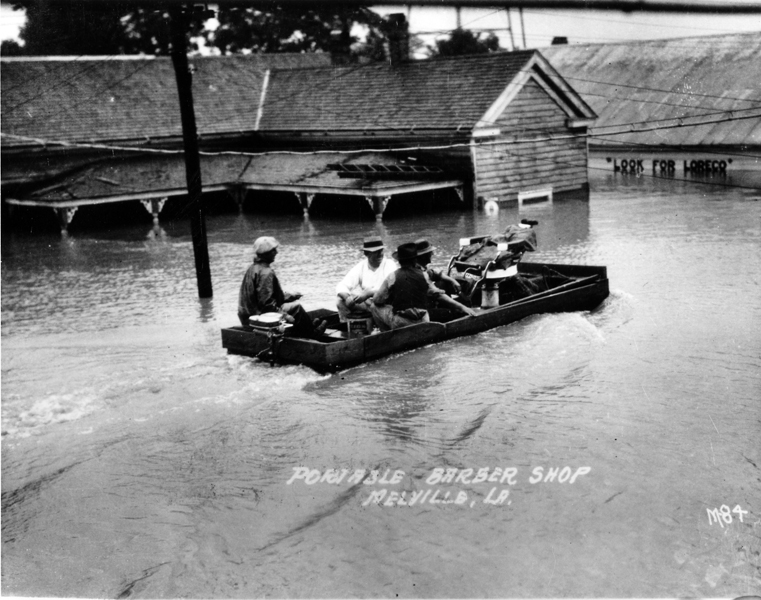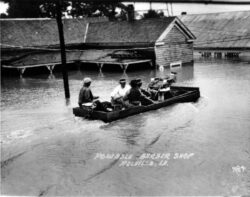Great Flood of 1927
The Flood of 1927 inundated nearly 26,000 square miles in 170 counties and parishes in seven states, driving an estimated 931,159 people from their homes.

Courtesy of State Library of Louisiana.
A black and white reproduction of a photograph of a boat with a barber chair in Melville, Louisiana, during the great flood of 1927.
The Flood of 1927 was described by US Secretary of Commerce Herbert Hoover as “the greatest peace-time calamity in the history of the country.” It inundated 16,570,627 acres (about 26,000 square miles) in 170 counties and parishes in seven states, driving an estimated 931,159 people from their homes. The Mississippi River remained at flood stage for a record 153 days. The flood caused more than $400 million in losses; 92,431 businesses were damaged and 162,017 homes flooded. According to various estimates, there were between 250 and 500 flood-related deaths. In Louisiana alone, 10,000 square miles in 20 parishes went underwater. The congressional response to the devastation, the 1928 Flood Control Act, had far-reaching social, political, and physical consequences in Louisiana and throughout the Mississippi River valley.
The prelude to the flood began in August 1926, when rainstorms began to swell streams in eastern Kansas, northwestern Iowa, and part of Illinois, all of which fed into the Mississippi River. In December, heavy rains in Oklahoma, Arkansas, and northern Louisiana filled the Arkansas and Red Rivers. During that fall, record rainfalls continued throughout the Mississippi River valley. By the end of January, major tributaries such as the Ohio River were overflowing their banks. In earlier times, this would not have been the problem it was in 1927; the Mississippi River and its tributaries once overflowed into natural drainage areas. But in the late 1800s, the Mississippi River Commission adopted a “levees-only” policy, which entailed the construction of levees that ran almost the full length of the river. While these levees prevented flooding for a period, they proved unable to withstand the floodwaters of 1927.
Threat to New Orleans
Through the early spring of 1927, the rains continued and the flood pushed downriver toward Louisiana. New Orleans received 11.16 inches of rain in February—compared to an average of 4.4 inches for the month—and steady rainfalls thereafter. Then, on Good Friday, April 15, 1927, more than 14 inches of rain fell on New Orleans in a single day, disabling the pumps that normally drained the city. The levees were not breached; river water did not rush in. Instead, the levees held the rainwater inside the city. That downpour also added more water to the Mississippi River as it rushed past New Orleans. The levees there were under pressure from both sides, and concerned citizens began to buy boats and stockpile food. As heavy rains continued in the Mississippi River drainage area above Louisiana, more than 20,000 men were put to work sandbagging levees between Baton Rouge and New Orleans.
The threat continued to worsen, however, and state government officials believed the levees would inevitably break. If the break happened below New Orleans, it would relieve pressure and spare the city from massive flooding. An upstream break, on the other hand, would send a disastrous flood into New Orleans. Despite strenuous objections from people living downstream, Governor O. H. Simpson and his advisors acquiesced to a plea from New Orleans civic leaders to blast a breach in the levee. This would give the flood a shortcut to the sea and drop the river level at New Orleans, at the cost of flooding further south. Engineers chose a westward loop in the river at Caernarvon and began blowing the levee apart on April 29. Over the next ten days they used thirty-nine tons of dynamite to open a channel that released 250,000 cubic feet of water per second from the river.
For two days before the dynamiting began the National Guard and major retailers from New Orleans sent convoys of trucks to evacuate the 10,000 residents whose homes and livelihoods would be washed away when the levee was breached. Most of the refugees went to stay with relatives. Those who had no place to go were brought to a warehouse in New Orleans. White people were housed on the fifth floor, Black people on the sixth. All had been promised full compensation for their losses, but the lucky ones would get an average of only $274 each, and thousands of them would get nothing.
Part of that was because nobody realized how much would be washed away. The financial leaders from New Orleans estimated that claims against a fund set up to compensate the victims would be between $2 million and $6 million. Instead, they amounted to $35 million, and there wasn’t enough money to go around. Additionally, the fund had to bear the expense of feeding the refugees at a cost of $20,000 a week. Refugees had to file a claim to receive compensation under a complicated system that divided payments into various categories, provided that no partial payments could be made, and without legal representation.
The refugees were caught between a system of legalities they did not understand and marshes still filled with water that kept them from going home. Most settled for pennies on the dollar, and practically all of them remembered that it was a man-made catastrophe that put them where they were. Adding to their anger, a natural breach of the levees subsequently eased pressure on the New Orleans levee; the blasting had been unnecessary. Though New Orleans had been spared, other parts of southern Louisiana were still in trouble, particularly in the Atchafalaya River and Bayou Teche basins to the west of the city.
Inundation of Southern Louisiana
The Atchafalaya River forks away from the Mississippi River at Simmesport in Avoyelles Parish. Though it and its tributaries were lined by levees, they were filled to overflowing, and part of the Mississippi River sought this shorter, straighter course to the sea. Smaller levees had begun to break in northern and central Louisiana in mid-May, but a disastrous break in the Atchafalaya River levee came on May 17 at Melville in St. Landry Parish. River water poured through the breach and began to rush to the south, soon joined by floodwaters caused by a break in a Bayou des Glaises levee to the north of St. Landry, in Avoyelles Parish.
The two floods met just north of Port Barre in St. Landry Parish on May 18. They combined to send an estimated 1.3 million cubic feet of water per second roaring to the south. The flood inundated Arnaudville at the St. Landry–St. Martin Parish line on May 19; Breaux Bridge and St. Martinville in St. Martin Parish two days later; then New Iberia and Jeanerette in Iberia Parish; and Franklin and Morgan City in St. Mary Parish. By the end of May, sixty thousand refugees were either in southern Louisiana camps or receiving Red Cross aid elsewhere. Thousands of cattle drowned and farm crops were wiped out as southern Louisiana turned into a lake 200 miles long and 50 to 100 miles wide. It was not until June that the floodwaters began to drain into the Gulf of Mexico
Once again, housing had to be found for tens of thousands of refugees who had no relatives to stay with. The Red Cross and local relief organizations set up tent cities and makeshift housing in Marksville, Mansura, Baton Rouge, Opelousas, Crowley, New Iberia, and elsewhere. Some twenty thousand people were housed in Lafayette alone. Parishes set up “rehabilitation committees” to find food and shelter for the displaced families.
When the water finally subsided, the Red Cross provided seed, tools, and rations to farm families facing the daunting task of surviving the winter and starting a new crop in the spring. Some six hundred prefabricated cabins were sent to St. Martin Parish and more like them elsewhere to temporarily replace destroyed housing. At the end of August 1927, an anonymous Associated Press reporter touring the Teche region was able to write, “Little farmhouses, bearing brown watermarks at various heights according to the depth of the water reached, are once more occupied, and some of the farmers are plowing in preparation for new plantings. A few have crops already growing, and cane and corn are making a brave attempt to put forth fruit despite the late start given them.”
Flood Policy Revision
The Flood of 1927 showed that levees alone would not solve the problem of flooding on the Mississippi River and forced the federal government to reconsider its flood control policy. As a result, huge tracts of lowland, called spillways, were set aside in south central and southeastern Louisiana. Massive gates were constructed to allow excess water to be diverted into these areas in times of severe flooding. Whole communities, such as Bayou Chêne, built upon a ridge in the Atchafalaya River basin, had to be abandoned because they were in the path of the floodwaters that might be diverted.
The flood drove many tenant farmers, most of whom were African American, off their land and, in many cases, out of the region. They migrated by the thousands to Chicago, Detroit, and other northern cities, changing the urban landscape in those places. In addition, a stingy fiscal policy that offered little aid to the flood victims, implemented under Republican President Calvin Coolidge, drove many African Americans from the party of Lincoln into the Democratic party, where they continue to be a considerable part of the constituency today.
Since Hurricane Katrina inundated New Orleans and the parishes to its south, there have been inevitable comparisons between the two disasters. Each was caused more or less by a man-made breach of a levee. Each caused widespread dislocation of large numbers of people for many months. Each changed both the physical and political face of the region and played a role in national affairs. Criticism over the handling of Katrina contributed in large measure to the decision by Gov. Kathleen Blanco not to run for reelection in Baton Rouge, and in lesser degree to a change of party in the White House in Washington. The Flood of 1927 opened the door for the populist Huey Long to make his first successful run for the governor’s mansion and played a substantial role in the selection of his party’s candidate for the presidency. Both calamities caused widespread dislocation of Black people, the first adding to a migration to the major urban cities of the north, the second to cities such as Houston and Atlanta. Both caused disruptions of life in southern Louisiana for thousands of people that arguably could be outranked only by the destruction caused during the Civil War.
